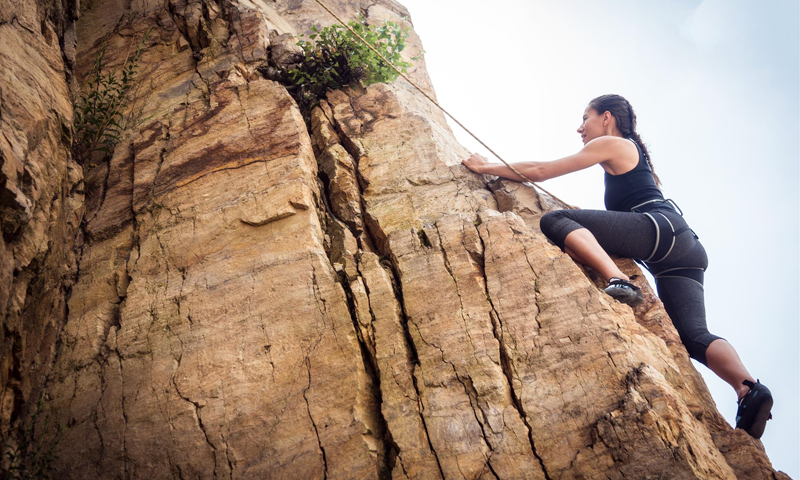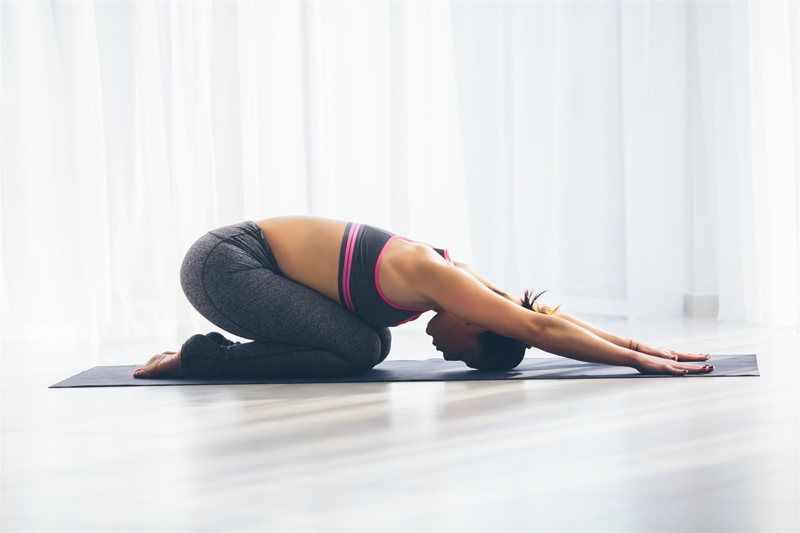
Letting Go
4th July 2018
Yoga for Surfers
5th July 2018Yoga for Climbers

To stay safe and injury-free whilst climbing, it’s important to build strength throughout the entire body. Strong muscles will allow you to pull yourself up with ease and maintain balance throughout the climb. While weight-training is a good way to build strength, this method tends to focus on specific areas of the body and miss out on others. Yoga is a great way to build strength throughout the entire body. As the practice uses your body weight as resistance against gravity, no additional weights are involved. This means that all you need to get started is a lightweight yoga vest and some comfy leggings. In this article, we explore yoga for climbers further.
Plank Pose
Popular amongst climbers of all sorts, Plank Pose builds strength in the core, legs, arms, and wrists. Addi-tionally, the pose improves shoulder stability to avoid injury whilst on the rocks. To perform Plank Pose, stand tall on your mat. Bending at the waist, lower your upper body towards the ground until your hands are touching the mat. Your body should now form a triangle. Next, slowly walk your hands forward and transfer your weight onto the balls of your feet. When you can, begin to lower your hips until they are aligned with your head and shoulders. Your shoulders should now sit just above your wrists. To hold the position, remember to keep your core engaged. You are in Plank Pose. Hold the asana for around 1 minute or as long as it feels comfortable to do so. When you first begin Plank Pose, you may only be able to hold the position for 30 seconds. If this is the case, don’t worry! The more you practice, the longer you will be able to hold the asana.
Seated Spinal Twist
Stretching the back, shoulders, and pectoral muscles, Seated Spinal Twist helps to increase flexibility. When climbing, supple muscles are essential for fluid movement. Additionally, the twist helps to realign the spine to prevent back pain and headaches from occurring. To practice the asana, sit on your mat with your legs out in front of you. Bend your right knee and place the sole of your right foot against the mat. Next, bend your left knee and bring your left foot under your right leg. If you can, place your left heel against your right buttock. Place your right palm on the mat just behind your right hip. Finally, place your left elbow on the outside of your right knee. You are in Seated Spinal Twist. With each breath, twist your torso a little further to deepen the stretch. Hold the posture for around 30 seconds before switching sides.
Bridge Pose
Another favourite amongst climbers, Bridge Pose opens the muscles in the chest, neck, and spine. When climbing, it’s common for tension to accumulate in these areas. If left untreated, the muscles quickly be-come stiff and uncomfortable. Additionally, Bridge Pose strengthens the muscles in the legs and buttocks to improve high-stepping and heel hooking. To practice the asana, lie flat on your back and bend your knees. Remember to keep the bottoms of your feet touching the mat. Allow your arms to relax and drop gently to the sides of your body. Tuck your chin into your chest and lift your back and buttocks off the mat to create a bridge. You are in Bridge Pose. Hold the position for 30 seconds before lowering yourself back to the mat.

Mountain Pose
Increasing strength and flexibility, Mountain Pose is another popular asana for climbers. Additionally, the posture increases the elasticity of the blood vessels to improve circulation. To perform Mountain Pose, stand on your mat with your feet beneath your hips. To maintain balance, keep your feet parallel to one another with your toes spread wide. Distribute your weight evenly through each foot, ensuring you are not shifting your centre of gravity forward or back. Next, engage your thighs and bring your tailbone in slightly. While your legs should be kept straight, it’s important to not lock the knees. As you inhale, lengthen your spine as you draw your head toward the ceiling. As you exhale, bring your shoulders down and back and reach your fingertips toward the floor. On your next inhale, bring your arms up and reach your fingers toward the ceiling. Finally, bring the palms of your hands together whilst still reaching your arms upward. You are in Mountain Pose. Hold the asana for around 30 seconds whilst breathing deeply. When you’re ready to release the pose, bring your arms back down to your sides as you exhale.
Thread the Needle Pose
When climbing, it’s often necessary to rotate your hips to reach the next hold. If the muscles are tight, this manoeuvre can become tricky. Thankfully, Thread The Needle Pose is ideal for increasing flexibility in the back and hips. To practice the asana, begin on all fours with your knees directly above your hips. Gently walk your left hand forward until you can reach your right arm underneath it. When you’re in the correct position, you should be able to rest your right cheek on the ground. You are in Thread The Needle Pose. Hold the asana for around 30 seconds before repeating on the other side. With each breath, increase the stretch by reaching the ‘threaded’ arm a little further under.
In Summary
Whether you’re an experienced climber or you’re just beginning, the asanas above will improve your craft. To avoid injury, consider picking up a comfortable yoga mat to practice on. Wearing a pair of lightweight yoga pants will ensure you can stretch without limitation and keep the body cool.

